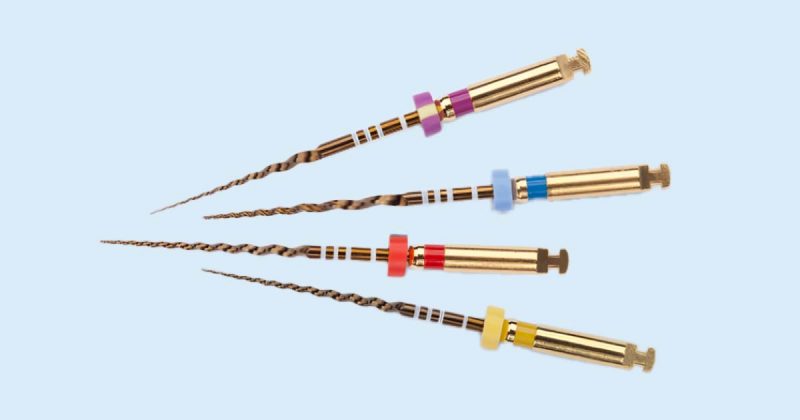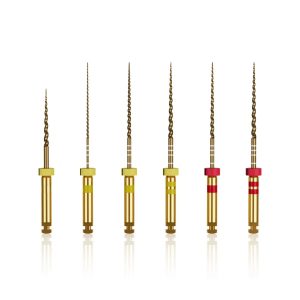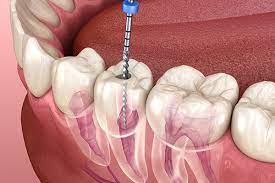Endodontic Rotary Files: Types, Advantages, Future Trends, FAQs

In day-to-day Dental practice, Endodontics plays a major role in saving teeth and reducing pain. At the heart of the specialty is the use of Endodontic Rotary Files, a revolutionary tool in Root Canal Surgery. The advent of NiTi has led to the development of numerous types of Endodontic Instruments that can be employed in a truly rotary or 360° revolution within a curved root canal.
Nickel–Titanium
This superelastic alloy does not exhibit proportional strain under stress until a specific level is attained that ultimately causes fracture
This unique property is due to the austenitic crystalline structure of the alloy which gets transformed into a martensitic crystalline structure under stress. Thus, Nitinol exhibits shape memory, i.e., the ability to return to its original shape once the stress is removed. Some of the rotary systems based on this technology are-
- ProTaper Next and Twisted Files.
- Controlled memory wires: This system consists of subjecting the files to a specialized heat treatment with an austenitic finish temperature of approximately 55°C, e.g., HyFlex rotary instruments.
Reciprocating Endodontic Instrumentation
The reciprocating instruments function at unequal bidirectional angles. The counterclockwise engaging angle is five times the clockwise disengaging angle and is designed to be less than the elastic limit of the file.
This novel reciprocating movement allows a file to progress more readily, cut efficiently, and effectively auger debris out of the canal, e.g., WaveOne Gold system and Reciproc Blue.
Clinical Note –
The advent of reciprocating instruments has brought in single-file shaping systems that aim to simplify the shaping procedure and reduce the operative time of the procedure. However, if improperly used, these files can cause inadvertent extrusion of periapical debris causing increased postoperative pain.
Canal Adaptive Endodontic Instrumentation
Traditional rotary and reciprocating instruments shape the canal according to the instrument design (based on instrument taper, tip diameter, and cross-sectional design). However, the root canal anatomy is highly diverse and eccentric in cross-section. Hence, another concept of shaping is in the development of file designs that adapt themselves to the canal anatomy.

Now Let us understand the difference between Manual Files and Rotary Files.
| FEATURE | MANUAL FILES | ROTARY FILES |
|---|---|---|
| SPEED | Slower, reliant on the clinician’s pace | Faster, efficient movement |
| FLEXIBILITY | Limited | Faster due to NiTi |
| USER FATIGUE | More strain on the Dentist | Less Strain as it is motorized |
| FILE SEPARATION | Higher risk of breakage with excessive force | Lower risk with torque control features |
| COST | Generally, it is less expensive | More expensive |
Benefits of using Rotary files
- Time utilized– The time taken in root canal is minimized. Their ability to clean up and shape the canal system fast and efficiently gives a dentist an opportunity to see more patients in a day.
- Safety features – The most notable of rotary file systems comes with a torque control feature which prevents a file from breaking. This is very essential because root canal anatomy is quite complex.
- Ergonomic and less Fatigue– These reduce the physical burden on dentists. The motorized system reduces the labor involved manually, thus it becomes comfortable for both the practitioner and the patient.
- Precision- The formation of rotary files allows a more uniform shape of the canal, which is essential in cleaning and sealing the canal right. It may lead to improved results and minimal complications.
Common Challenges with Rotary Files
- Probable file splitting: One of the critical issues related to rotary files is the splitting of a file within the canal. However, for this reason, factors such as excessive torque, misuse, and curvature of the canal may trigger the case.
- Anatomical complexities: There are many complicated canal anatomies in most of the teeth that may pose a challenging task for the file. This increased complexity may not allow for complete cleaning and shaping of the tooth if proper care is not taken. There should be education of the dentist with respect to this anatomical variation and their proper management.
- Overuse of file in the canal: The high speed and efficacy of rotary files sometimes make one be over-aggressive in removing dentin to get the canal open and cleaned promptly. This often compromises the strength of the tooth structure and, consequently, its integrity. There is therefore a need to find a balance between cleaning and preserving tooth structures.

Future Trends in Rotary Files
- Advanced Research– Ones that will bring newer, more pliable, and stronger materials to be used for rotary files. Perhaps newer nickel-titanium alloys or composite materials allow a better stress resistance.
- Smart Technologies – On can envision and predict that smart technology will be introduced into rotary systems, torque and speed feeding or adjustment due to changed resistance in the canal.
- Personalized File Systems: Personalized rotary file systems tailored to the anatomy of individual patients may emerge. A better outcome and reduced complications for the patient are definite outcomes of this.
- Emergence of Minimally Invasive: With dentistry as a minimally invasive specialty in focus, design of rotary files could become even more sophisticated to remove less amount of tooth structure while maintaining the same amount of efficiency in cleaning and shaping.
- Simulation Training: With VR and AR, virtual reality can easily turn out to be a future of training. With such aspects, dental professionals would be able to master a number of different skills, as for instance the application of rotary files, in simulations that are nearly as close to reality and, therefore, could be developed until such a time before their application in the clinic.
Frequently Asked Questions about Rotary Files
1. What does a Rotary file consist of?
Rotary files are usually made of the metallic alloy nickel-titanium (NiTi) because of its flexibility and strength.
2. How do Rotary files compare to hand files?
Rotary files are driven by an endo motor, therefore, they shape a canal faster and more effectively compared to manual files. They do not require the movement of hands and therefore, are very fast.
3. Are Rotary files safe?
Yes. Rotary files are safe if used properly. However, proper training and technique will minimize risks associated with file separation.
4. How would I select the right Rotary file for my practice?
Think about the types of cases you commonly treat, the budget, and the special features and benefits for different file systems.
5. Are Rotary files single-use use or may be reused?
Most rotary files are single-use to maintain a clean and effective file. However, some systems may be reused. Always follow the manufacturer’s instructions.
6. What do I do with a broken Rotary file in a canal?
If the file breaks in the canal you must examine it carefully. It might be required to try to remove it or just take them to have alternative treatment.
Conclusion
Endodontic rotary files are a game-changer in modern dentistry, making root canal treatments efficient, precise, and very comfortable for the patient. An appreciation for the options and their respective best practices can enable dentists to make the most of root canal treatments with good outcomes. It is only by embracing new tools that elevates your practice and society as a whole.
Remember that knowledge is power, and knowledge about new tools and techniques helps maintain an upper hand for the best treatment of patients. So, get ready, dive into the world of rotary files, and transform your approach to root canal treatments!



No Comment